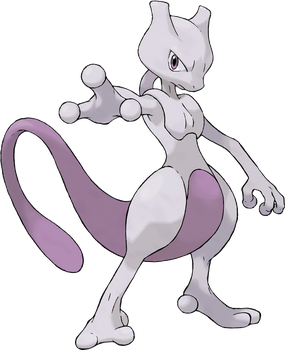
Mewtwo will be pokedexed after Mew after May 1,2025

Pokémon Ruby Version and Pokémon Sapphire Version are 2002 role-playing video games developed by Game Freak and published by The Pokémon Company and Nintendo for the Game Boy Advance. They are the first installments in the third generation of the Pokémon video game series, also known as the "advanced generation". After years of Nintendo being the sole publisher of the franchise in all regions, The Pokémon Company co-published the games for the first time since the establishment of the joint-owned company in 1998. They were first released in Japan in late 2002, and internationally in 2003. Pokémon Emerald, a third version, was released two years later in each region. Remakes of the two games, titled Pokémon Omega Ruby and Alpha Sapphire, were released for the Nintendo 3DS worldwide in November 2014, exactly twelve years to the date of the original Ruby and Sapphire release date, with the exception of Europe, where it released a week later.
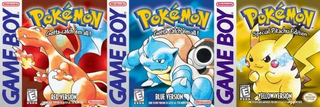
Pokémon Red Version and Pokémon Blue Version are 1996 role-playing video games (RPGs) developed by Game Freak and published by Nintendo for the Game Boy. They are the first installments of the Pokémon video game series, and were first released in Japan as Pocket Monsters Red and Pocket Monsters Green, followed by the special edition Pocket Monsters Blue later that year. The games were released internationally in 1998 and 1999 as Pokémon Red and Pokémon Blue, while an enhanced version named Pokémon Yellow Version: Special Pikachu Edition, was released in Japan in 1998 and in other regions in 1999 and 2000.

Final Fantasy Crystal Chronicles is an action role-playing video game developed by The Game Designers Studio and published by Nintendo for the GameCube. It was released in 2003 in Japan and 2004 in North America, Europe and Australia. A remastered version for Nintendo Switch, PlayStation 4, Android, and iOS was released in August 2020. A spin-off of the Final Fantasy series and beginning of the series of the same name, Crystal Chronicles was the first title in the franchise to be released for a Nintendo home console since Final Fantasy VI in 1994.
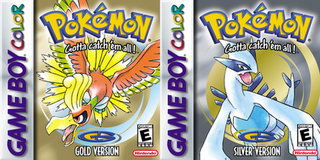
Pokémon Gold Version and Pokémon Silver Version are 1999 role-playing video games developed by Game Freak and published by Nintendo for the Game Boy Color. They are the first installments in the second generation of the Pokémon video game series. They were released in Japan in 1999, Australia and North America in 2000, and Europe in 2001.

Pokémon Diamond Version and Pokémon Pearl Version are role-playing video games developed by Game Freak and published by The Pokémon Company and Nintendo for the Nintendo DS in 2006. They are the first installments in the fourth generation of the Pokémon video game series. They were first released in Japan on September 28, 2006, and released in North America, Australia, and Europe in 2007. Pokémon Platinum, a third version, was released two years later in each region. Remakes titled Pokémon Brilliant Diamond and Shining Pearl were released for the Nintendo Switch worldwide on November 19, 2021. A prequel, Pokémon Legends: Arceus, was released for the Nintendo Switch on January 28, 2022.

Pokémon is a Japanese series of video games developed by Game Freak and published by Nintendo and The Pokémon Company under the Pokémon franchise. It was created by Satoshi Tajiri with assistance from Ken Sugimori. The first games, Pocket Monsters Red and Green, were released in 1996 in Japan for the Game Boy, later released outside of Japan as Pokémon Red Version and Blue Version. The main series of role-playing video games (RPGs), referred as the "core series" by their developers, has continued on each generation of Nintendo's handhelds. The most recently released core series games, Pokémon Scarlet and Violet, were released on November 18, 2022, for the Nintendo Switch.

Pokémon Battle Revolution is a turn-based strategy video game in the Pokémon series developed by Genius Sonority and published by The Pokémon Company and Nintendo. It was released for the Wii on December 14, 2006, in Japan; on June 25, 2007, in North America; on November 22, 2007, in Australia, and on December 7, 2007, in Europe. Along with being the first Wii incarnation of the Pokémon video game franchise, it is also the first Wii game to use the Nintendo Wi-Fi Connection in North America and Japan and the second Wii game to wirelessly interact with the Nintendo DS handheld.

Dragon Quest Monsters, released in North America as Dragon Warrior Monsters, is the first video game in the Dragon Quest Monsters series. It was released in Japan by Enix on September 25, 1998, and co-published by Eidos Interactive in Europe and North America in 2000. It was the first Dragon Quest game to be released in Europe. The game cartridge is compatible with both the black-and-white Game Boy and the Game Boy Color; a second printing of the game was made after the Game Boy Color itself was released. The game was remade for the PlayStation in a compilation Dragon Quest Monsters 1+2 Hoshi Furi no Yūsha to Bokujō no Nakamatachi. A mobile phone incarnation titled Dragon Quest Monsters i was released in Japan on January 28, 2002.
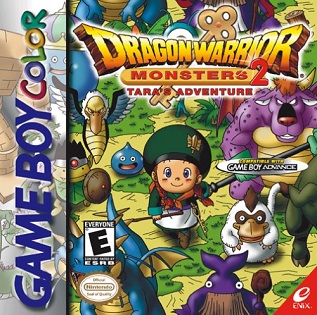
Dragon Warrior Monsters 2, known in Japan as Dragon Quest Monsters 2, is a role-playing video game published by Enix for the Game Boy Color. It is the second Dragon Warrior Monsters game for the Game Boy Color and features two different versions of the same game, Cobi's Journey and Tara's Adventure. Both games were remade in 2002 for the PlayStation in a compilation game called Dragon Quest Monsters 1+2 and released only in Japan. The Nintendo 3DS version combined both games into one and was released only in Japan in 2014 with the title Dragon Quest Monsters 2: Iru and Luca's Marvelous Mysterious Key. The 3DS version was later brought to iOS, Android on August 6, 2020, in Japan.

Monster Rancher Battle Card GB, known in Japan as Monster Farm Battle Card GB is a handheld game released in 1999 for the Nintendo Game Boy Color system. It is the first game in Tecmo's Monster Rancher Battle Card series, featuring a card game incorporating the popular characters from the Monster Rancher series. It was followed by Monster Rancher Battle Card Episode II for the Sony PlayStation entertainment system which featured additional monsters.
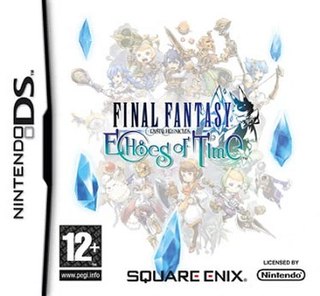
Final Fantasy Crystal Chronicles: Echoes of Time is a Wii and Nintendo DS action role-playing game in the Final Fantasy Crystal Chronicles series developed by Square Enix.

Final Fantasy Crystal Chronicles: My Life as a Darklord is a 2009 tower defense video game developed and published by Square Enix for the Wii and distributed through the WiiWare download service. The game is an entry in the Final Fantasy franchise, forming part of the Crystal Chronicles subseries. Taking place after Final Fantasy Crystal Chronicles: My Life as a King, the game follows the titular Darklord as she defends her mobile tower from waves of attacks as it travels across the kingdom.

Foto Showdown, known in Japan as Monster Finder, is a turn-based video game made exclusively for the Nintendo DSi. It was released in Japan on November 19, 2009 and in North America on March 9, 2010. The game revolves around players using their monsters to battle against rivals. By winning tournaments and battles, players can advance through the game through upgrades and unlocking more powerful items. The game allows player to take advantage of the DSi outer camera by allowing them to spawn certain monsters for use in battle based on the dominant colors in the photo.

Pokémon Black Version and Pokémon White Version are 2010 role-playing video games developed by Game Freak and published by The Pokémon Company and Nintendo for the Nintendo DS. They are the first installments in the fifth generation of the Pokémon video game series. First released in Japan on 18 September 2010, they were later released in Europe, North America and Australia in 2011. Sequels to Black and White, Pokémon Black 2 and Pokémon White 2, were released for the Nintendo DS in 2012.

Lufia: Curse of the Sinistrals, released as Estpolis: The Lands Cursed by the Gods (エストポリス) in Japan, is an action role-playing game video game co-developed by Neverland and Square Enix for the Nintendo DS. It is a remake of the 1995 Super Nintendo Entertainment System game Lufia II: Rise of the Sinistrals, also developed by Neverland. The character re-designs are by former Square Enix character designer, Yusuke Naora.

Puzzle & Dragons is a puzzle video game with role-playing and strategy elements, developed and published by GungHo Online Entertainment for the iOS, Android, and Amazon Fire platforms.

Moe Chronicle, commonly known in Japan as Genkai Tokki Moero Chronicle, is a dungeon crawler role-playing video game developed by Compile Heart for the PlayStation Vita. It is the second game in Compile Heart's Genkai Tokki series of video games, following Monster Monpiece and preceding direct sequel Moero Crystal and Genkai Tokki: Seven Pirates. Moe Chronicle was released on May 15, and an Asian release featuring Chinese and English subtitles was later published by Sony Computer Entertainment and released on May 5, 2015. It was then released on Steam with English, Japanese and Chinese subtitles on August 16, 2017 as Moero Chronicle. On April 26, 2019 the game was released as Moero Chronicle Hyper on the Nintendo Switch with pre-orders opening for a physical version later that year.

Monster Hunter Stories is a role-playing video game developed by Capcom and Marvelous and published by Nintendo for the Nintendo 3DS. It is a spinoff title in the Monster Hunter series and features a drastically different gameplay focus. Unlike previous titles in the franchise, Monster Hunter Stories lets players take on the role of a Rider instead of a Hunter, and are able to take part in a traditional turn-based battle system. Major changes and additions featured in this title include hatching eggs and befriending monsters, battling alongside them, executing special kinship techniques, and customizing monsters' abilities and appearance. The game was released in Japan on October 8, 2016, and in North America, Europe and Australia in September 2017. Later, a high-definition mobile version of the game was released on December 4, 2017 in Japan and September 25, 2018 worldwide. The Nintendo 3DS version includes support for Amiibo figures, with a first set launching alongside the game, and a second set launching two months later. An anime series Monster Hunter Stories: Ride On is a loose adaptation of this game, and the sequel Monster Hunter Stories 2: Wings of Ruin was released in 2021.



















